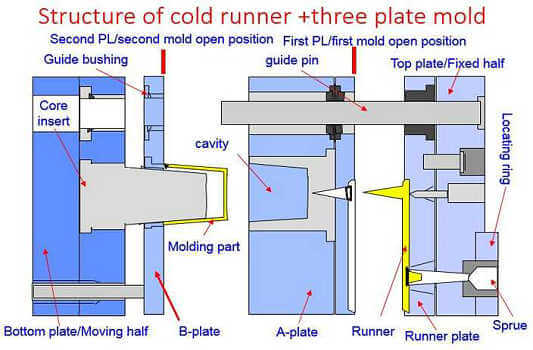Was ist eine Zweiplatten-Spritzgussform?
Zwei-Platten-Spritzgussform (2-Platten-Spritzgussform), 3-Platten-Spritzgussform und alle anderen Arten von Kunststoff-Spritzgussformen sind Formentypen, die beim Kunststoff-Spritzguss verwendet werden, in 2-Platten-Formen, in denen zwei separate Formplatten verwendet werden, um den Formhohlraum zu bilden, eine Platte, die wir „A“-Platte oder A-Taschenplatte nennen, die den Hohlraum und die feste Hälfte enthält, und normalerweise nennen wir dies Hohlraumseite, die andere Platte ist „B“-Platte (oder Kernseite/bewegliche Seite), die Kerneinsätze enthält, die die bewegliche Hälfte sind, das Auswerfersystem befindet sich ebenfalls auf der Kernseite.
Der Kunststoff wird durch den Anguss in die Formhöhle eingespritzt, und dann wird die B-Platte gegen die A-Platte geschlossen, um das Teil zu formen. Sobald der Kunststoff abgekühlt und verfestigt ist, wird die B-Platte geöffnet und das Teil ausgeworfen. Diese Art von Form wird im Allgemeinen für kleinere, einfachere Teile mit minimalen Hinterschneidungen oder komplexen Geometrien verwendet.
Vorteile der Zweiplattenform

Zwei-Platten-Spritzgussform
Das Schöne am Zweiplatten-Design ist seine Einfachheit. Dies bringt mehrere Vorteile mit sich:
- Kostengünstig: Mit weniger Teilen und einem unkomplizierten Design sind Zweiplattenformen die wirtschaftlichste Option. Daher empfiehlt sich die Zweiplatten-Spritzgussform für die Massenproduktion weniger komplexer Teile.
- Einfache Wartung: Aufgrund ihrer einfachen Konstruktion sind Zweiplattenformen einfacher zu warten und zu reparieren.
- Schnelle Zykluszeiten: Der einfache Öffnungs- und Schließmechanismus ermöglicht schnellere Produktionszyklen im Vergleich zu komplexeren Formen.
- Geeignet für eine Vielzahl von Materialien: Sie können eine Vielzahl von Thermoplasten verarbeiten und sind daher vielseitig für verschiedene Anwendungen geeignet.
Nachteile des Zweiplatten-Spritzgusses
Zweiplattenformen bieten zwar zahlreiche Vorteile, haben jedoch auch Einschränkungen:
- Ästhetik der Angussmarkierung: Die Stelle, an der der geschmolzene Kunststoff in die Kavität eintritt (die Angussmarkierung), kann auf dem Endprodukt eine sichtbare Markierung hinterlassen.
- Komplexität der Teile: Sie haben Probleme mit Teilen, die Hinterschneidungen, tiefe Kerne oder Gewinde aufweisen. Diese Merkmale erfordern zusätzliche Mechanismen, die die Komplexität und die Kosten erhöhen.
- Angussabfall: Das am Formteil befestigte Angusssystem muss entfernt werden, wodurch Kunststoffabfall entsteht.
Der Formprozess in Aktion
Die Spritzgussform mit zwei Platten durchläuft einen präzisen Zyklus zur Herstellung von Kunststoffteilen. Hier ist eine vereinfachte Aufschlüsselung:
- Klemmen: Dabei werden B-Seite und A-Seite durch Anwendung eines hohen Drucks fest miteinander verbunden, wodurch eine perfekte Abdichtung gewährleistet wird.
- Einspritzen: Der geschmolzene Kunststoff wird unter hohem Druck durch das dafür vorgesehene Teil oder den Anguss in die Formhöhle eingespritzt.
- Verdichten und Halten: Nach dem Füllen der Kavität wird der Druck aufrechterhalten, um die Schrumpfung des Kunststoffs während der Abkühlung auszugleichen.
- Kühlung: Um das Kunststoffteil zu verfestigen, wird die Form mit Wasserkanälen gekühlt.
- Formöffnung: Die B-Seite zieht sich zurück und erzeugt eine Trennlinie, an der sich die beiden Formhälften trennen.
- Auswerfen: Stifte oder andere Mechanismen drücken das fertige Kunststoffteil aus der Kavität.
- Entfernen des Angusskanals: Der übrig gebliebene Kunststoff aus Anguss und Kanälen (Angusskanal genannt) muss möglicherweise manuell vom Teil entfernt werden.
Unterschied zwischen Zweiplatten- und Dreiplattenform
Eine Zwei-Platten-Form und eine Drei-Platten-Form Beim Kunststoff-Spritzguss werden unterschiedliche Formen verwendet. Der Hauptunterschied besteht in der Anzahl der Platten, die zur Bildung der Formhohlräume verwendet werden.
Zwei Plattenformen:
Stellen Sie sich eine Muschelschale vor. Dies ist das grundlegende Konzept einer 2-Platten-Spritzgussform. Diese besteht aus zwei Hauptkomponenten. Erstens die feste Platte oder auch „A-Seite“ genannt und zweitens die bewegliche Platte oder „B-Seite“.
Die Magie geschieht innerhalb dieser beiden Hälften. Die A-Seite enthält einen Hohlraum, der die gewünschte Form des endgültigen Kunststoffteils nachbildet. Die B-Seite kann einen Kern haben, der interne Merkmale bildet oder einfach als Gegenstück zum Hohlraum fungiert. Diese beiden Seiten kommen zusammen und bilden einen abgedichteten Behälter, in den geschmolzener Kunststoff eingespritzt wird.
- haben zwei separate Formplatten, die „A“-Platte und die „B“-Platte.
- Die A-Platte enthält die Kavität und den Kern, und die B-Platte enthält den Auswerfermechanismus.
- Der Kunststoff wird durch den Anguss in die Formhöhle eingespritzt und dann wird die Platte B gegen die Platte A geschlossen, um das Teil zu formen.
- Sobald der Kunststoff abgekühlt und fest geworden ist, wird die Platte B geöffnet und das Teil ausgeworfen.
- Dieser Formtyp wird im Allgemeinen für kleinere, einfachere Teile mit minimalen Hinterschneidungen oder komplexen Geometrien verwendet.
Drei Plattenformen:
- haben drei separate Formplatten, die „A“-Platte, die „B“-Platte und die „C“-Platte (oder Angussplatte).
- Die Platte A enthält die Kavität, die Platte B den Kern und die Platte C den Angusskanal, den Angusskanalschieber mit Auswerfer auf der Kavitätsseite (dieser Auswerfer wirft nur den Angusskanal aus, den wir auch Angusskanalschieber nennen).
- Der Kunststoff wird durch die C-Platte (Angussplatte) in die Formhöhle eingespritzt. Anschließend wird die B-Platte gegen die A-Platte geschlossen, um das Teil zu formen.
- Sobald der Kunststoff abgekühlt und ausgehärtet ist, wird die C-Platte geöffnet, um den Angussstab mit der C-Platte herauszuziehen und dann den Anguss mit einem Drücker von der Angussplatte auszuwerfen. Anschließend wird die B-Platte geöffnet und das Teil ausgeworfen.
- Dieser Formtyp wird im Allgemeinen für größere, komplexere Teile mit Hinterschneidungen oder anderen Merkmalen verwendet, die mit einer Zweiplatten-Spritzgussform nicht hergestellt werden können.

3-Platten-Form vs. 2-Platten-Form
Zusammenfassend lässt sich sagen, dass der Hauptunterschied zwischen Zweiplatten- und Dreiplattenformen darin besteht, dass sich bei Zweiplattenformen der Angusskanal auf der A- oder B-Platte befindet, die sich auf der Trennlinienebene befindet, und durch das Auswerfersystem teilweise ausgeworfen wird, während bei Dreiplattenformen der Angusskanal an der C-Platte (Angussplatte) klebt und später durch den Drücker ausgeworfen wird. Diese Formen sind komplexer und teurer als Zweiplattenformen.
Haben Sie ein Projekt, bei dem Kunststoff benötigt wird? Formenlieferanten? Bitte kontaktieren Sie uns, um ein Angebot zu erhalten. Wir sind in der Lage, 2- oder 3-Platten-Spritzgussformen herzustellen.






